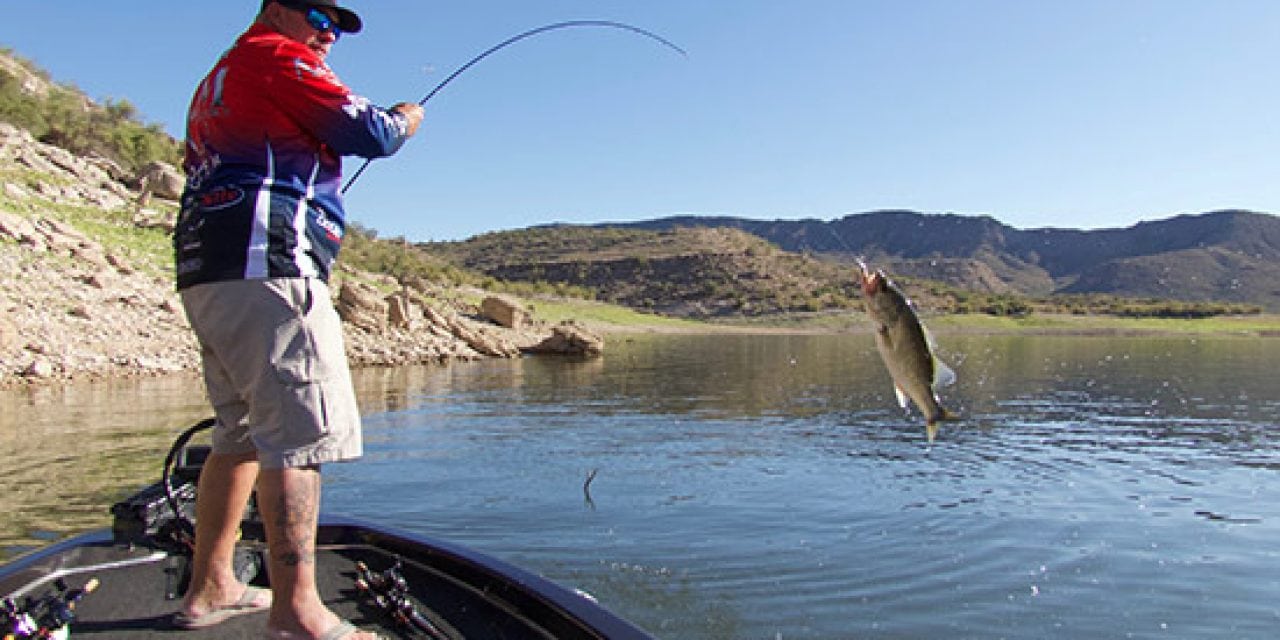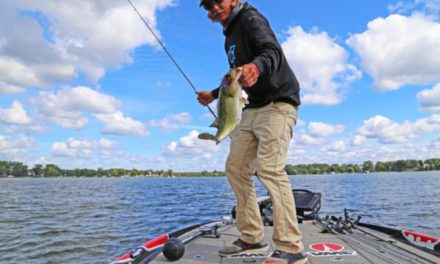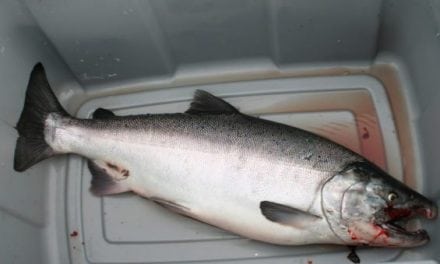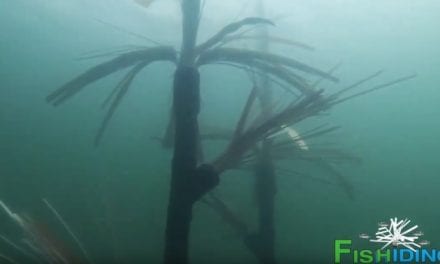Lake Pleasant in Arizona is one lake where anglers must learn to adapt to changing conditions. The lake is known for extreme changes – the lake level fluctuates as much as 100 vertical feet every year, which means that the fish move constantly. If you don’t learn how to follow them, you’ll blank. Charlie Ponder, a tournament angler who fishes Pleasant often, knows how hard this can sometimes be.

We went out on Pleasant with Charlie as summer was just transitioning to fall. “The lake has come down eight feet since last weekend,” he told us. “That means the fish are probably still moving out.” The weather this time of year in the Arizona desert is fickle. It may be hot one day and cool the next, with chilly nights in between. The surface temps also fluctuate, even from one area of the lake to another. What works in one spot may not work in another. The great thing about this lake is that the entire river arm (Agua Fria River) is closed from mid-December until Mid-June in order to let the bald eagles nest in peace. This turns the entire river into an unmolested hatchery, resulting in great fishing.

Charlie says there was a really good spawn this year, so there are tons of small bass around. Since early in the year there has been an awesome fluke bite on, and that bite was producing great numbers and an occasional bigger fish. But as he watched his graph, Charlie noticed that the fish were coming up shallow but going back down to twenty feet deep or more. To target these deeper (and usually bigger) bass, he tied on a 5-inch Lake Fork Flutter Spoon – a flashing silver one with a blue tint. Dropping this spoon down to deeper water all but eliminated the small fish – he started putting 3-pounders in the boat right away.

There are a lot of tournaments on Lake Pleasant, and anglers who are unfamiliar with the lake often have trouble deciding what to do. When Ponder is pre-fishing, he splits the big lake into two separate areas: from the main ramp to the Humbug Creek, and from the Humbug on down the river. He’ll start fishing in one of the coves near the main ramp, such as Honeymoon, and just work his way around. One of the keys is to watch your graph, but this can fool you because Pleasant is also home to white bass and stripers. Be prepared to catch a lot of big stripers when you start dropping those 5-inch spoons.
Charlie says there’s often no early morning bite so don’t worry if you don’t get bit right away. Pleasant fishes similarly to Mead, he says, so concentrate on structure. To figure out what the fish are doing, have your partner fish a different bait. Jerkbaits and crankbaits are ideal search baits, and you can fish them fairly fast. One bait that has seemed to be working all year so far is the fluke, Little Dipper, or Yamamoto D-Shad. Rig them on 4/0 wide gap hooks, and fish them on braid with an 8-pound-test fluorocarbon leader. Use a good double uni knot to join the two lines, and use a big treble hook on the bend of the main hook as a trailer hook. When you slip the treble on, pay attention to the three hooks and make sure you have one hook pointing directly at the bait so you can insert it without twisting the hook. This leaves two hooks down by the tail and it will really improve your hook-up ratio.
This little swimbait bite couldn’t be easier to fish – just cast it out and twitch it back. You can let it stop and sink now and then if you want to. This rig has been producing on almost every lake in central Arizona all year long. Great colors are all shad imitations. The bass feed heavily on shad here, so shad colors in jerkbaits and swimbaits are perfect. Charlie actually throws the soft jerkbaits on baitcasting equipment, but most people choose spinning gear for such light lures. Another way to fish a small fluke or Yamamoto D-Shad is on an underspin jig like a Roadrunner or an Xcite Baits XB-360 Underspin. This, says Charlie, either works or it doesn’t. It’s more of a spring and winter thing, but in the fall he’ll almost always give it a try. You can also try putting a little nail weight into the head of the bait to make it spiral down as it falls.

The thing about Pleasant is this: if you can catch fish here, you can translate that success to almost any other big desert impoundment in the country, and vice versa. Charlie says that in the Junior Bassmasters High School Open, the San Diego team came in 4th on Pleasant, and they had never fished here before. They told him it fished just like their desert lakes.
When he sees deep fish, Charlie picks up the big spoon. The thing about fishing these, he says, is that you will lose baits. There are still tons of submerged trees in Pleasant, and while these often hold big fish, they also like to keep your big baits. He casts the spoon out (and you can cast it a long way!), allows it sink to the bottom, rips it up, then lets it fall again. This works great summer and winter, he says – whenever the fish are deep. During these transition times from summer to winter, a combination of spoons and shallow baits are doing the trick.
If nothing fast is working, a drop shot rig with a 4-inch worm fished off shore is called for. Ponder says to look for an area with trees, brush, etc. He searches for rock piles, humps, long points, etc. Watch your graph for fish and adjust your leader length accordingly. Good colors on Pleasant include light pink, brown with purple, green pumpkin, and purple with blue.
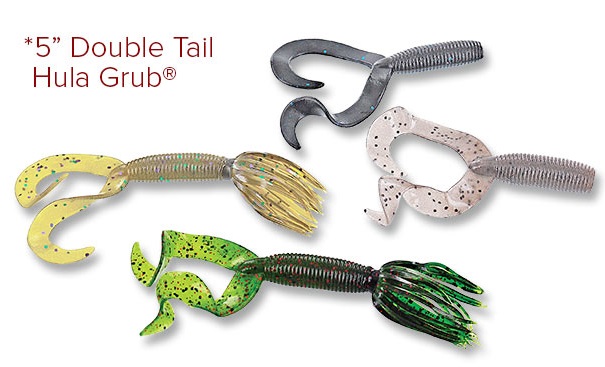
Pleasant has plenty of bluffy walls, in the main lake coves as well as in the river. These vertical structures can hold fish all year long – the trick is to figure out how deep they are, whether they are largemouth, and what they want. You can drag a football head jig around down there with a Yamamoto Hula Grub (Charlie’s all-time confidence bait/pictured above) in smoke with hologram flakes, smoke pepper, pumpkin seed, or smoke sparkle, or you can bounce it from ledge to ledge. Fish these on a good stout jig pole with heavy fluorocarbon or even braid. You may be fishing deep, so you won’t want a lot of stretch when you set the hook. Use the lightest jig you can get away with, and use a fast reel so you don’t let the fish get slack line and throw the bait. Drop shot rigs also work on these walls, but be prepared – you’re going to lose a lot of baits, because if the trees don’t get you, the rock crevices will. Your best bet is to just take the boat over your snagged bait. Usually it will come right off if you can get the boat behind it. Check your line, knots, and hook points after every fish and every snag.

Lake Pleasant is either boom or bust for most anglers, but if you can figure it out, you can fish just about any desert lake with success. Charlie spends so much time on Pleasant that he has figured out a lot about it, but he’s pretty sure that no one always get a fat sack here. However, if you can be versatile and adapt to changing conditions, your odds both here and at other lakes out west will be a lot better.
Charlie Ponder is the Director of the Phoenix Junior Bassmasters and has been a part of the program for seven years. They now have almost 50 kids involved, including several girls, and he says the hardest thing is finding boat captains for the events. A boat captain simply drives the boat for a couple of kids while they fish the tournament. The 8- to 10-year-olds also bring a parent along. To be a boat captain, you need to be at least 18 years old, and have a boat and insurance. Without captains, there would be no club. These kids are the future of bass fishing, so if you can possibly help out in the Phoenix area, please go to www.phoenixjuniorbassmasters.com and click “about us” to find the contact information. There are just three tournaments left this season: November on Apache, March on Havasu, and April on Pleasant.
By M.L. Anderson, Inside Line
The post Adapting to Changing Patterns appeared first on ODU Magazine-North America’s #1 Digital Fishing Magazine.

